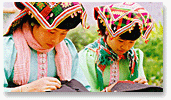Home » Ethnic People » Khang
The Khang People

Khang is an ethnos having resided for long now in northwestern Viet Nam, largely in the high-land districts of Thuan Chau, Quynh Nhai and Muong La of Son La province; Phong Tho, Muong Lay, Muong Te and Tuan Giao of Lai Chau province. “Khang” people speak the northern Mon-Khmer language.
Though with a small population which stands approximately at 4,000 now, the “Khang” ethnos is divided into different local subgroups such as Dang, Hoac, Don, Sua, self-styled Hang (Hang Beng, Hang Coi), or Bren (in Muong Te, Lai Chau). Different subgroups have practiced different modes of farming which is considered their main form of economic activity. Some subgroups build their terraced fields and milpa by mode of nomadic farming; some adopt rotation croppings, while others settle down, practicing wet rice cultivation, with milpa farming only as their sidelines which help increase their family income.
Though living in mountain regions, the Khang people prefer building their houses along rivers. They are very good at building piragua not only for their own use but also for sale to Thai and other ethnic groups nearby, as evidenced through a Thai saying: “No boat is better than the boat made by the Khang and no knife is sharper than the knife made by the Lao,”
Khang people group together in hamlets also called “ban”, each comprising from 15 to 40 houses built either simply like huts by nomadic Khang or on stilts by permanent settlers, with two unparallel roofs, wattle walls and doors opened at the front or lean-to.
A Khang hamlet is headed by an official called “quan cai” elected by people or appointed by the Thai ethnic group’s rulers. In big hamlets, “quan cai” are allowed to force a number of families to work as slaves (called “nhoc” which is similar to the typical form of slave labor, the “hlun”, in the Central Highlands of Viet Nam), ploughing the fields for 15 days, transplanting crops for 15 days working the terraced fields, harvesting crops… for them. In small hamlets, “quan cai” do not mobilize “nhoc” labor, but hamlet inhabitants have to do all the milpa farming for them.
In charge of the spiritual life of the hamlet, people is the sorcerer called “Pa 0” or “U ti a”, who is greatly admired and respected by people. Those who are cured of illness by “Pa 0” through his practice of offering and worship, shall come to “Pa 0” working the fields for his family in order to express their gratitude and making such offerings as a chicken, a bottle of alcohol or a jar of alcohol, four arms spreads of cloths and a certain sum of money. Once every two or three years. Pa 0 has to organize a rite to express thanks to “Ma ngat a”, his ghost, who has helped his work go smoothly without any troubles.
The Khang society is organized on the basis of small patriarchal families and the customary laws of this ethnic group protect the male, For instance, after the wedding and particularly after the period of matrilocality by men. the Khang women totally depend on their husbands who may divorce them without any compensations for the former’s families. On contrary, if a wife wishes to divorce her husband. She has to pay 5 silver coins (a former monetary unit in the mountain region), a jar of alcohol and 10 silver coins a year as compensation for his matrilocality. If the man’s matrilocality duration exceeds five years, a buffalo must be added to the fine,
However, traces of matriarchat regime that once existed in the Khang society are still found in coustorms and practices of this ethnic minority group. For instance, during a man’s matrilocality, if his children were born they would be given the family name of their mother, or the mother’s family name was given to girls and the father’s family name to 30ns. if a couple divorced while the Tu Bay Hap or Tu Ca Blong, a party recognizing the couple husband and wife was yet organized the property and children would belong to the mother. Or if unfortunately, both the mother and father died during that period, children would worship only their mother, not the father. Such traces were also clearly seen in the role of the maternal uncle (the mother’s brother) in deciding the marriage of his nieces and nephews who had to worship him when he died.
The Khang customary laws on marriage seem to be complicated, under which boys aged 15-16 and girls 14-15, might court each other- Yet, after 5 nights’ courting, if the boy did not marry the girl, he was subject to a fine of one jar of alcohol and a party organized with chicken and rice for hamlet inhabitants, asking for their pardon.
If a couple commits themselves to the married life after the courting period, the boy’s family will send people to the girl’s, proposing the marriage. All expenses for the wedding and marriage shall be borne by the boy’s family, which usually asks the bridegroom’s aunt to bring betel and areca-nut to the bride’s family, asking for the bridegroom’s matniocality. Whether agreeing to this or not. the girl’s family accepts the betel and areca-nut, which wilt be handed over to the bride’s uncle later. After three days, if the uncle does not return the betel and areca, the marriage is meant to be accepted by the girl’s family.
Three years after the wedding, the bridegroom family has to organize the “Tu bay hap” ceremony. Only with this ceremony can the couple be officially recognized husband and wife and be together after they die. All people in the hamlet are invited to such a lavish party.
Khang customary laws strictly prohibit marriage between people of the same bloodline divorce initiated by women as well as adultery and advocate monogamy. Those who violate such customs and practices would be severely punished. Meanwhile, such laws also protect the private ownership of property. Any acts of infringing upon other community and severely punished before the public. Therefore, such social evils as thievery, burglary, encroachment upon other people’s land, etc, almost do not happen. It can be said that the customary laws and their punitive forms against violations thereof have constituted effective measures to maintain order and security and to contribute to the enhancement of community relationships In Khang hamlets. Alt these must be inherited and brought into active play in order to make the relationships among the Khang community stronger and healthier.

